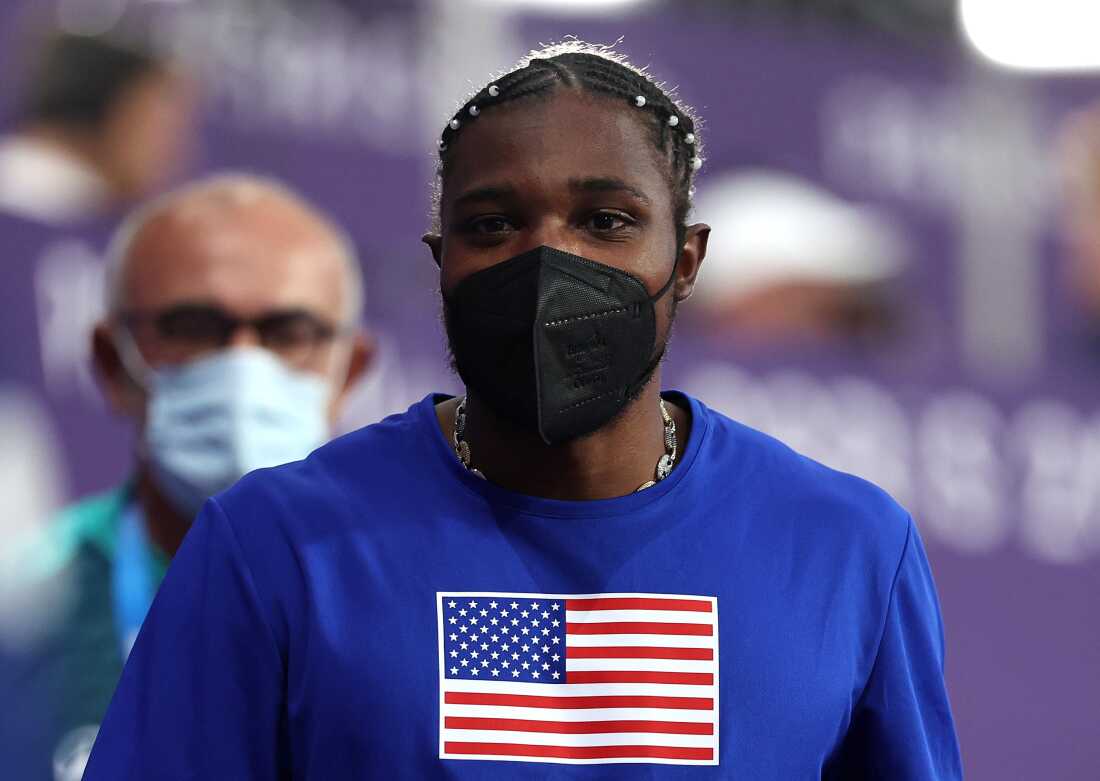
Olympic sprinter Noah Lyles is the latest famous American to get COVID in this summer’s surge. Lyles won a bronze medal in the 200-meter race despite an active COVID infection. Masks continue to be a good idea in risky situations.
Hannah Peters/Getty Images
hide caption
toggle caption
Hannah Peters/Getty Images
Four years after SARS-CoV2 sparked a devastating global pandemic, U.S. health officials now consider COVID-19 an endemic disease.
“At this point, COVID-19 can be described as endemic throughout the world,” Aron Hall, the deputy director for science at the CDC’s coronavirus and other respiratory viruses division, told NPR in an interview.
That means, essentially, that COVID is here to stay in predictable ways.
The classification doesn’t change any official recommendations or guidelines for how people should respond to the virus. But the categorization does acknowledge that the SARS-CoV2 virus that causes COVID will continue to circulate and cause illness indefinitely, underscoring the importance of people getting vaccinated and taking other steps to reduce their risk for the foreseeable future.
“It is still a very significant problem, but one that can now be managed against the backdrop of many public health threats and not as sort of a singular pandemic threat,” Hall says. “And so how we approach COVID-19 is very similar to how we approach other endemic diseases.”
A fuzzy definition
Ever since the coronavirus exploded around the globe, officials have been referring to COVID as a “pandemic,” which occurs when a dangerous new disease is spreading widely in different countries.
The definition of “endemic” is fuzzier, but generally refers to a disease that’s become entrenched in places, like malaria is in many parts of Central and South America and sub-Saharan Africa, forcing people to learn how to live with it.
And even though COVID is still spreading widely, daily life has returned to normal for most people, even during this summer’s wave of infections. On Wednesday, Noah Lyles competed in his Olympic race despite a symptomatic COVID infection and won a bronze medal. President Biden worked from home during his recent COVID infection.
COVID seems to be becoming a normal part of life. So NPR reached out to the CDC and other experts to find out if they think the time had come to start referring to COVID as endemic.
“Yeah, I think in the way that most people think about the notion of endemic — something that’s just around that we have to manage on an ongoing basis — yeah, absolutely, COVID is endemic in that way,” says Dr. Ashish Jha. Jha is the dean of the Brown University School of Public Health, who served as the White House COVID-19 response coordinator for President Biden.

As in previous years, COVID infections are surging this summer, and plenty of people are seeing the dreaded two lines on self-tests. The biggest COVID surges happened in early January each year.
Ulrich Baumgarten/Getty Images
hide caption
toggle caption
Ulrich Baumgarten/Getty Images
But not everyone agrees. Some epidemiologists say COVID may be on the way to becoming endemic, but the virus is still too unpredictable to reach that conclusion yet. This summer’s surge, for example, started surprisingly early and is turning out to be significantly bigger than expected.
The latest data from the CDC shows high or very high levels of the virus in wastewater in almost every state.
“There’s still a lot of unpredictability with this virus,” says Katelyn Jetelina, an epidemiologist who writes the popular newsletter: Your Local Epidemiologist. “And a lot of scientists including myself think it’s going to take at least a decade for SARS-CoV2 to really find this really predictable pattern. I hope that over time that it will fade into the background. But we’re just not there yet.”
Hall and Jha agree that COVID remains somewhat unpredictable, but argue it’s become predictable enough to be considered endemic.
“The best way to describe COVID right now is as endemic but with these periodic epidemics,” Hall says. “And those epidemics can vary in terms of their timing and magnitude. And that’s exactly why ongoing vigilance and surveillance is critical.”
And even if COVID is endemic, that doesn’t mean it’s no longer a problem.
“Endemic doesn’t necessarily mean good,” William Hanage, an epidemiologist at the Harvard T.H. Chan School of Public Health. “Tuberculosis is endemic in some parts of the world. And malaria is endemic in some parts of the world. And neither of those are good things.”
50,000 deaths a year
COVID is still killing hundreds of people every week, primarily older people and those with other health problems. According to a new CDC report, COVID’s no longer the third-leading cause of death, but the disease still ranks as the 10th top cause of death. COVID is projected to kill close to 50,000 people every year, according to the new report.
“I think we have to be very careful in just writing this off and saying, ‘Well, it’s just a mild infection.’ It’s not,” says Michael Osterholm, who runs the Center for Infectious Disease Research and Policy at the University of Minnesota. “It is particularly a significant risk for those who are older and those who have underlying conditions. The good news is for most younger, otherwise healthier people this will be like having a flu-like infection.”
But even if someone doesn’t get deathly ill, COVID can still make people pretty miserable, knock them out of work or school. And then there’s long COVID.
“I certainly hope that this is not our new normal for COVID,” says Samuel Scarpino, who studies infectious diseases at Northeastern University in Boston. “I had it a few weeks ago, and just about everybody that I know has had it. It would be a real bummer if we’re in this situation where we’ve got COVID [in summer], and then we get into the fall with RSV, and then we have influenza and then it’s basically year-round respiratory infection risk.”
So whether COVID can officially be considered endemic, people are still going to need to think about protecting themselves by getting vaccinated once or twice a year and considering masking up in risky situations and around high-risk people.
Better treatments and new vaccines that could prevent the spread of the virus would also help, as would better ventilation, many infectious disease experts say.
“We still need to do more I think to get this virus under control,” Jha says. “This is a virus that we have to deal with. We can’t just ignore it. We can do better and we should do better.”
It remains critical to continue monitoring the spread of the virus and its evolution, especially to try to spot the emergence of any new, more dangerous variants, Jha and other experts say.
“We’re going to have to continue to live with COVID,” says Caitlin Rivers, an epidemiologist at the Johns Hopkins Center for Health Security. “It’s one more thing people have to deal with. It’s another reason your kids might miss school or you might miss work or another thing to think about when planning gatherings. We’re stuck with it.”
